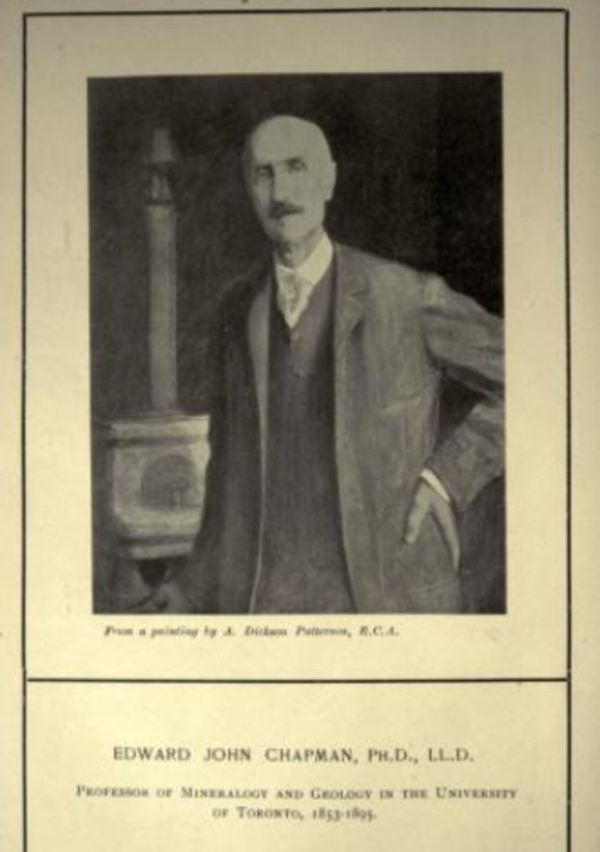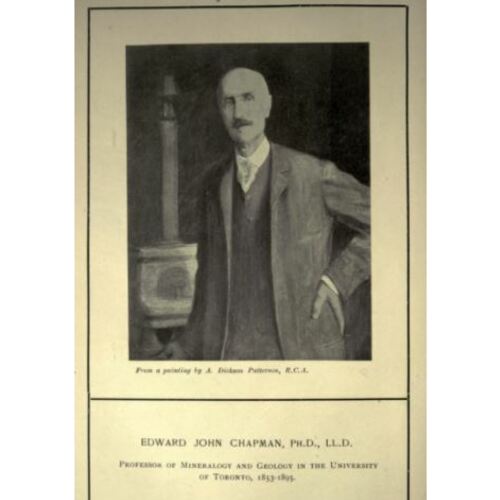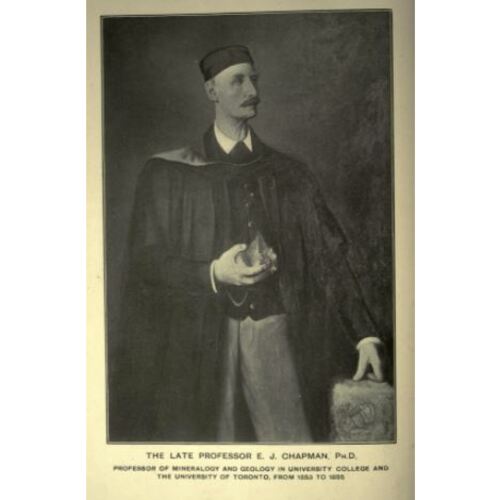
Source: Link
CHAPMAN, EDWARD JOHN, university professor, mineralogist, and author; b. 22 Feb. 1821 in Kent, England; m. first a daughter of a Colonel Cogan, and they had a son, who predeceased Chapman; m. secondly Frances Sutherland, daughter of a Captain Sutherland of Sydney, N.S.; d. 28 Jan. 1904 in Hampton Wick (London), England.
Edward John Chapman was born at an inn on the borders of Kent and Surrey because his parents, en route from France, could not reach home in time for his birth. His father died when he was two. After a preliminary private education, he was sent to France and Germany to further his studies; in Paris he attended the Lycée Henri-IV and the Sorbonne. In the late 1830s he followed friends to Algeria, where he enlisted in the French army of occupation. After being wounded in battle and confined to hospital, he was brought back to England by a relative to convalesce.
Chapman decided to study civil engineering, and he worked under William Froude on the staff of Isambard Kingdom Brunel, the famous railway and shipping engineer. He also became interested in identifying mineral specimens and published two small treatises in London, Practical mineralogy . . . (1843) and A brief description of the characters of minerals . . . (1844). In 1849 he obtained a professorship of mineralogy at University College, London.
Four years later University College in Toronto [see John McCaul*] appointed Chapman to its newly created chair of mineralogy and geology, a position he would hold until 1889, when he joined the School of Practical Science at the University of Toronto (he would retire in 1895). At the same time he played an important public role as a supporter of the Geological Survey of Canada, especially as an interpreter and popularizer of its annual scientific reports [see Sir William Edmond Logan*]. Chapman broadened his own research interests in geology and mineralogy to include Canadian formations. He travelled widely to conduct commercial assessments of deposits of economic minerals, and he significantly refined blowpipe analysis, which tested for mineral traces through their chemical reactions to flame. Much of his published work, both theoretical and practical, appeared in the Canadian Institute’s Canadian Journal, on whose editorial board he served for many years.
In the same publication, Chapman in 1860 reviewed Charles Darwin’s controversial On the origin of species and James Bovell*’s anti-Darwinian Outlines of natural theology . . . Although he remained sceptical of the theory of natural selection, he respected the massive amount of scientific evidence accumulated by Darwin. In contrast, he criticized Bovell’s “compilation” as being outside the realm of scientific inquiry and, indeed, erroneous in the light of glacial and Tertiary geology. Chapman normally eschewed such theoretical discussions in favour of works like his “Popular exposition of the minerals and geology of Canada,” which appeared in parts from 1860 to 1864. In this series, later published as a book, he was at his best, seeking first to convey practical knowledge to the general reader, secondly to enable “surveyors, farmers, and others” to recognize Canadian minerals, and thirdly, to serve as an introduction to the publications of the Geological Survey.
Edward J. Chapman received a phd from the University of Göttingen, in the kingdom of Hanover (Germany), in 1862 and an honorary lld from Queen’s College, Kingston, five years later. He was a charter-member of the Royal Society of Canada in 1882. An expert fencer, accomplished amateur actor, and published poet, he made his mark as a scientist less for original research than for his contribution to an equally important Victorian ideal, the widest possible diffusion of useful knowledge.
A chronological list of Chapman’s scientific publications, excluding book reviews, can be found in Science and technology biblio. (Richardson and MacDonald); listings for his non-scientific works appear in CIHM Reg.
Times (London), 6 Feb. 1904: 12. Carl Berger, Science, God, and nature in Victorian Canada (Toronto, 1983), 56. DNB. W. H. Ellis, “Edward John Chapman, ph.d, ll.d” and “The late Professor E. J. Chapman,” Univ. of Toronto Monthly, 2 (1901–2): 229–31 and portrait opp. p.229, and 4 (1903–4): 151–53 and portrait opp. p.151. Geological Magazine (London), new ser., decade 5, vol.1 (1904): 144. Mineralogical Magazine (London), 14 (1907): 65. The University of Toronto and its colleges, 1827–1906, [ed. W. J. Alexander] (Toronto, 1906), app., 233–34.
Cite This Article
Suzanne Zeller, “CHAPMAN, EDWARD JOHN,” in Dictionary of Canadian Biography, vol. 13, University of Toronto/Université Laval, 2003–, accessed December 21, 2025, https://www.biographi.ca/en/bio/chapman_edward_john_13E.html.
The citation above shows the format for footnotes and endnotes according to the Chicago manual of style (16th edition). Information to be used in other citation formats:
| Permalink: | https://www.biographi.ca/en/bio/chapman_edward_john_13E.html |
| Author of Article: | Suzanne Zeller |
| Title of Article: | CHAPMAN, EDWARD JOHN |
| Publication Name: | Dictionary of Canadian Biography, vol. 13 |
| Publisher: | University of Toronto/Université Laval |
| Year of publication: | 1994 |
| Year of revision: | 1994 |
| Access Date: | December 21, 2025 |




